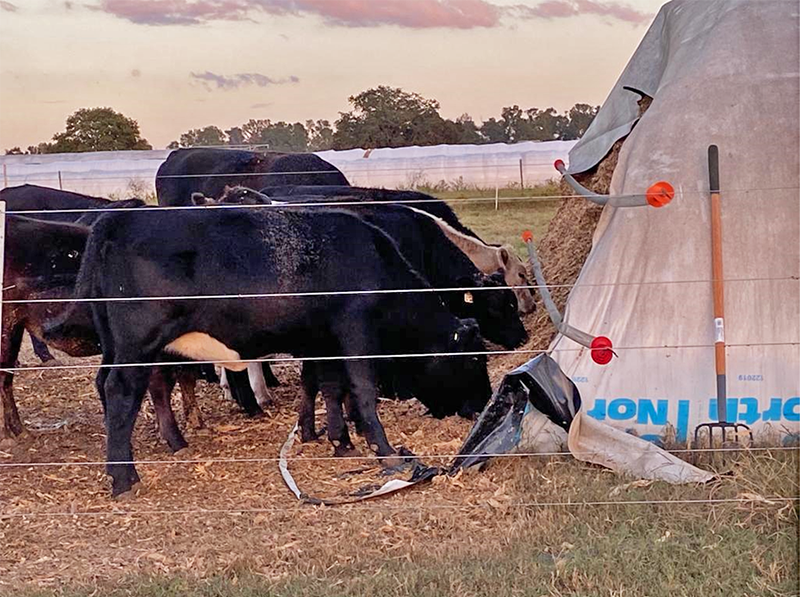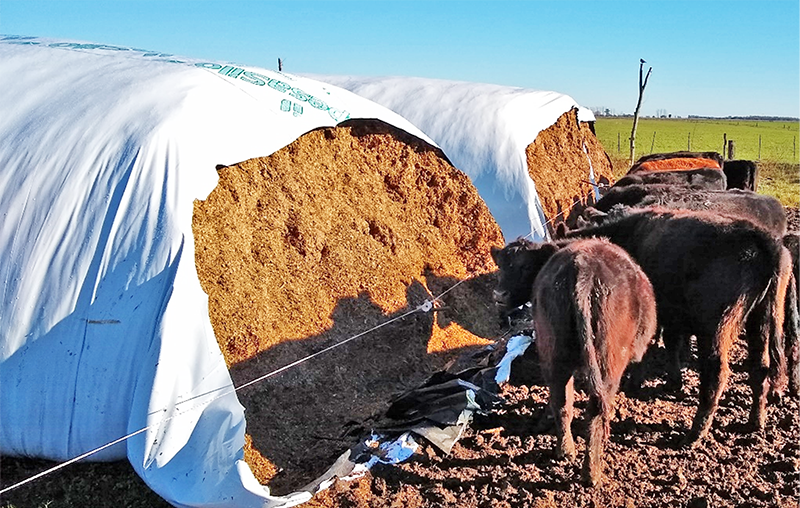Nicolas DiLorenzo, Federico Podversich, and Federico Tarnonsky, UF/IFAS North Florida Research & Education Center, Marianna
Feeding silage to cattle has many nutritional benefits but often requires more time and labor than other supplemental feeding options. One option being evaluated at the North Florida Research and Education Center (NFREC) is the use of “self-feeding” silage bags as shown in Figure 1 below. The use of ‘self-feeding’ ensiled forages is a suitable alternative for producers that want to reduce input costs such as equipment use and labor. This is a low-cost approach, where a silage bag can be opened at one end, and with the use of two hot (electric fence) wires running across the opened face of the silage bag, and fencing off the rest of the bag, cattle are allowed to eat silage free-choice from the bag. This approach can be implemented on a small or large scale for both growing and mature cattle. While there is no control of the silage intake, this free-choice approach system eliminates the need for tractors, feed wagons, or diesel. In today’s economy, cost reductions are always appealing.

Figure 1. Heifers feeding from the opened face of the self-feeding silage bag at the North Florida Research and Education Center. Credit: Federico Tarnonsky, UF/IFAS
=
Practical tips
Silage bags should be located in a well-drained location to avoid excessive mud accumulation. The preferred area would be the most elevated terrain available, to take advantage of the natural drainage of water on rainy days. The bag should be opened facing south as this will provide maximum sunlight exposure to keep the soil surface dry. It is very important to fence off the sides to prevent cattle access to the bag and ruptures. Preferably, this would be done with an electric fence, or existing perimeter fences to minimize fencing costs.
Once the bags are opened, oxygen penetrates the ensiled forage, and this allows yeasts to grow and cause spoilage. Therefore, it is important to allow cattle to consume enough material every day, so it does not spoil and waste (this is called daily frontal advance). As a rule of thumb, cattle should consume at least 1 foot of bag per day in the winter and 1.5 feet during summer to outpace spoilage and feed primarily fresh silage. The use of heterofermentative inoculants during the ensiling process should be strongly considered to help extend the aerobic stability of the feed once it is exposed to oxygen.
The easiest way to control cattle’s frontal advance into the bag is with the use of electric fence. Cattle learn quickly how to eat silage from the front of the bag while avoiding the hot wire.
106 weaned heifers at NFREC fed corn silage from a self-feeding 12-foot bag.
=
The self-feeding area should be attended daily to make a new section of the bag available by removing a “slice” of the plastic bag and to adjust the hot wires forward, allowing cattle access to fresh material every day. This can be handled by one person pretty quickly. The only tools needed for the daily care are a pocketknife and a pitchfork (to pile up any loose silage at the bottom and push behind the wire).
=
How many animals can I stock per bag?
This is an important question, and it will depend on the size of the bag, moisture content, packing density and daily frontal advance. Roughly, it can vary from 50 to more than 100 head per bag. It is very important that all animals have access to the silage bag and that competition is minimized. A good indicator of a correct stocking density is when all cattle in the paddock are resting at the same time, and none of the animals exhibit anxious behavior or are looking for feed. Weighing the group every few weeks or monthly can help determine if the target gains are being achieved. It is also very important to place similar groups of cattle together, avoiding mixing, for example, weaned calves with mature cattle, which may compete for access, if the stocking density is not optimal.

Figure 2. Placing multiple bags next to each other allows feeding of higher numbers of cattle. In this picture, 200 weaned heifers grazed ryegrass during the day, and during the evening were brought to a large pen where they were self-fed from three 9-foot bags of ensiled grain sorghum. Credit: Fredrico Podversich, UF/UIFAS
=
Nutritional considerations
If you intend to utilize silages for growing cattle it is important to remember that most ensiled forages (with the exception perhaps of winter annuals or legumes) may be deficient in protein, and therefore protein supplementation may be required. In a test conducted recently at the NFREC, a reduction of 40% in average daily gains (ADG) was observed in heifers ‘self-fed’ corn silage without protein supplementation (1.5 lb/d), when compared with heifers fed corn silage + 10% cottonseed meal on a dry matter basis (2.5 lb/day).
The most common forages ensiled in the area are corn and sorghum (forage or grain varieties). These silages have fairly high energy due to their starch content when harvested at the right maturity. Perennial warm season grasses and winter annuals can also be ensiled but require wilting to reduce moisture. Furthermore, in the case of cow/calf operations, ‘self-feeding’ silage bags of warm season perennials like Limpograss or Bermudagrass can be utilized to feed mature cows during periods of grass shortage, avoiding the need to feed round bales.
If you have any questions about how to set up a self-feeding silage bag for your operation, contact your local county extension office for more information.
- 2025 Florida Bull Test Sale Sets Average Price Record - March 7, 2025
- 2025 Florida Bull Test Sale – January 18 - January 10, 2025
- Intake Limiters:Old Technology for Modern Beef Cattle Supplementation - September 20, 2024
